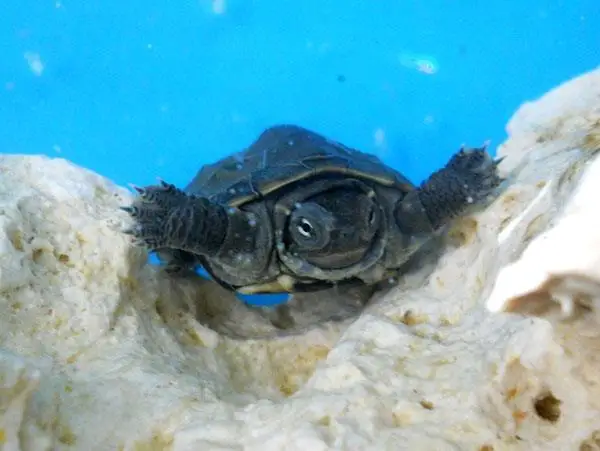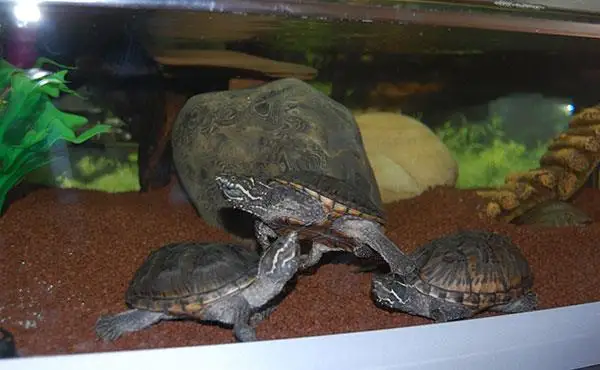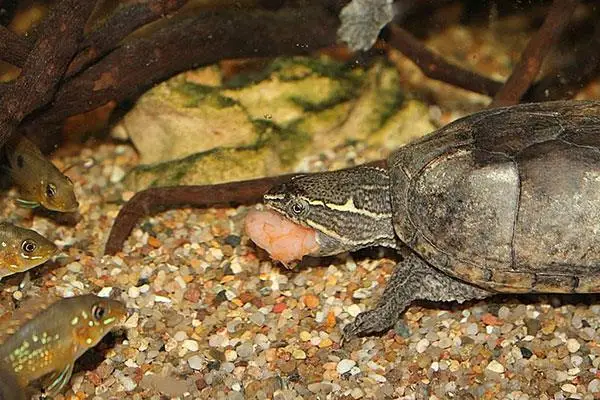Variety Overview
The main subspecies of the musk turtle include the Mississippi musk turtle, razorback musk turtle, giant musk turtle, flattened musk turtle, and the Mexican giant musk turtle from the genus Staurotypus.
Mississippi Musk Turtle
Found in southern Ontario, along the coast from Maine to Florida, extending westward to central Texas and northward to southern Wisconsin.
The turtle’s head features two light-colored stripes and has whiskers on its chin and throat. Its carapace is smooth or has three ridges that are high-arched and elongated without serrations; it ranges in color from olive-brown to dark gray and often appears blurry due to algae coverage. Juvenile turtles have ridges and patterns on their carapace that consist of irregular dark stripes or spots. The plastron is relatively small with eleven scutes and an inconspicuous hinge joint. Male turtles have a horn-like hard protrusion at the end of their tails, while the inner side of their hind limbs features two small raised scales. Female turtles have very short tails that end in a sharp point.
Razorback Musk Turtle
The Razorback Musk Turtle (Sternotherus carinatus) is indigenous to the southern regions of Mississippi extending to Texas.
This species features a carapace with a distinct keel that creates a steep incline. The scutes range in color from light brown to light orange, adorned with dark spots or radiating stripes and bordered by darker edges. These markings tend to fade as the turtle ages. Its plastron is yellow and lacks a gular scute, resulting in only 10 scutes in total. A single, slightly shaped hinge joint can be found between the pectoral and abdominal scutes. The nose of this turtle is somewhat tubular, and it possesses barbels on its chin.
Giant Musk Turtle
This species is found from central Georgia to central Florida, extending west to eastern Mississippi and the easternmost part of Louisiana, and north throughout eastern Tennessee.
The carapace features keels and shingles-like vertebral scutes. It is brown or orange with dark-edged seams and may display dark spots or radiating stripe patterns. The plastron is small, pink or yellow, with an indistinct hinge joint and a single gular scute. Barbels are only present on the chin. The head shows dark spots or stripes. Males have a large tail ending in a spike; females have tails that just reach the edge of the carapace.
The Flattened Musk Turtle
Native to the Black Warrior River system in Alabama, USA, the Flattened Musk Turtle stands out among its genus for its relatively flat carapace. This carapace is leaf-brown with black spots or stripes. The turtle’s plastron is pink or beige and features a single hinge joint that is not very prominent. The head also has distinctive black spots.
Mexican Giant Musk Turtle
Mainly found in North America, Mexico, Belize, Guatemala, Honduras, and Belize.
The carapace of the Mexican Giant Musk Turtle can grow up to 40 cm in length. It has a reddish-brown color and an elongated oval shape with three prominent ridges running down the center. Its plastron is yellow without gular or humeral scutes. The axillary and inguinal scutes are relatively large. This turtle has a large brown head adorned with white worm-like patterns on the top, sides, and back of its neck. It features a hooked lower beak. The underside of its neck is pale yellow. Its limbs are grayish-brown with black spots, and it has a short tail.

Morphological Features and Identification
The musk turtle measures about 8-13.5 cm in length, making it one of the smallest species of aquatic turtles found in the United States. Its carapace features keels (most prominent in juveniles) and shingle-like vertebral scutes. The shell is typically brown or orange with dark-edged seams and may exhibit dark spots or radiating stripes. Juvenile musk turtles have jet-black, rough shells that become smoother and lighten to shades of brown or black as they mature. They are easily recognizable by two white lines running from their snout to their neck.

Breeding Information
Musk turtles lay between one and four clutches of eggs annually, with each clutch containing two to three oval-shaped eggs, measuring about 29mm in length. In one instance, someone discovered 17 clutches of giant musk turtle eggs in a sand pile that was about 13cm high near a flowing spring. These turtle eggs are delicate and exquisite like porcelain; they start off as translucent pink when first laid and gradually turn opaque white as the embryos develop. The incubation period ranges from 13 to 16 weeks.
